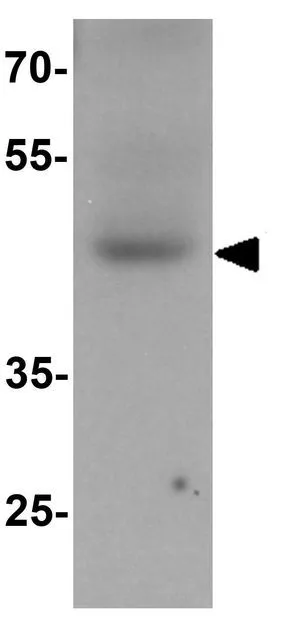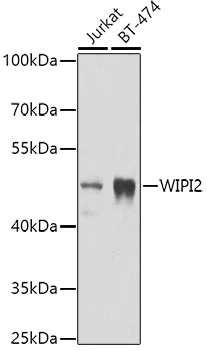
WB analysis of human testis tissue lysate using GTX31513 WIPI2 antibody. Working concentration : 1 microg/ml
WIPI2 antibody
GTX31513
ApplicationsWestern Blot, ELISA
Product group Antibodies
TargetWIPI2
Overview
- SupplierGeneTex
- Product NameWIPI2 antibody
- Delivery Days Customer9
- Application Supplier NoteWB: 1 - 2 microg/mL. *Optimal dilutions/concentrations should be determined by the researcher.Not tested in other applications.
- ApplicationsWestern Blot, ELISA
- CertificationResearch Use Only
- ClonalityPolyclonal
- Concentration1 mg/ml
- ConjugateUnconjugated
- Gene ID26100
- Target nameWIPI2
- Target descriptionWD repeat domain, phosphoinositide interacting 2
- Target synonymsATG18B, Atg21, CGI-50, IDDSSA, WIPI-2, WD repeat domain phosphoinositide-interacting protein 2, WD40 repeat protein interacting with phosphoinositides 2, WIPI49-like protein 2
- HostRabbit
- IsotypeIgG
- Protein IDQ9Y4P8
- Protein NameWD repeat domain phosphoinositide-interacting protein 2
- Scientific DescriptionWD40 repeat proteins are key components of many essential biologic functions. They regulate the assembly of multiprotein complexes by presenting a beta-propeller platform for simultaneous and reversible protein-protein interactions. Members of the WIPI subfamily of WD40 repeat proteins, such as WIPI2, have a 7-bladed propeller structure and contain a conserved motif for interaction with phospholipids (Proikas-Cezanne et al., 2004 [PubMed 15602573]).[supplied by OMIM, Mar 2008]
- Storage Instruction-20°C or -80°C,2°C to 8°C
- UNSPSC12352203




